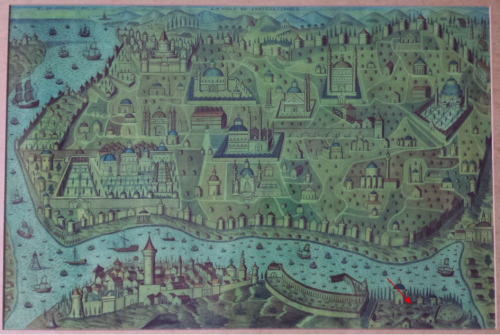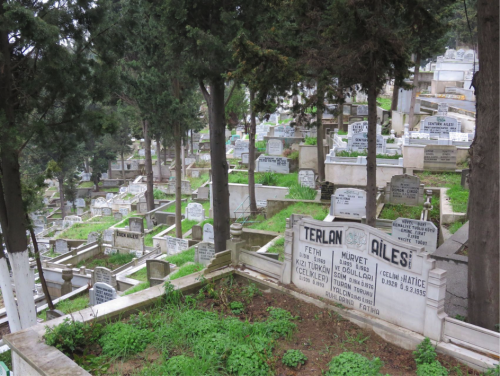
ANAMED 2015–2016 Fellow Caroline Laforest gets to learn Istanbul, its inhabitants, and the size of its population through its historic cemeteries…
When I discuss with my co-fellows, I realize how we are all divided between the desire to always study more, because our time at ANAMED is precious, and that of exploring more of Istanbul. I assume this is one of the reasons why, when I am working at the desk in my room, I can’t help but to continually watch the representation of an old map entitled ‘La ville de Constantinople’ which is framed on the wall. I don’t know exactly when this map was drawn, but I would say sometime between the 16th and 17th centuries AD. It is very funny to try to identify each represented monument, from the biggest Ottoman complexes to the more modest ruins, like the Byzantine Column of Marcian. But as an anthropologist studying ancient burial practices, my eyes are drawn to the representation of a cemetery. This funeral space is localized in the northern bottom of the Golden Horn, facing the Eyüp Külliye. We can observe on the map some tombs with hexagonal sections, but also other kinds of burials, signalized by stelae and separated from the former by a small wall. This funeral space was certainly dedicated to another community.
A little research on Google Maps allowed me to see if this cemetery still exists today. In this part of the city, today called Hasköy, there are three cemeteries: Hasköy Mezarlığı, Sütlüce Mezarlığı, and Musevi Mezarlığı, the Jewish Cemetery. In addition, I discovered that the Jewish graves are regularly characterized by this hexagonal shape, and this area was then inhabited primarily by several Jewish communities. I found mention of the Armenian Hasköy Cemetery, too.
Apparently Istanbul contains 320 or 333 Muslim cemeteries (my sources disagree), and 65 cemeteries for others religions. I decided to visit a large Muslim cemetery first, not far from Beyoğlu: the Zindan Arkası Mezarlığı, by walking through Kasımpaşa area. It is a quite modern cemetery, ideal for trying to comprehend contemporary burial practices. On a rainy day, I arrived with a friend at this funeral space, whose tombs, isolated or in family concessions, are disposed along paved paths strewed with pines. The day before a colleague’s friend asked us why we were keen on cemeteries. A part of the answer is simple: to enjoy this quiet and green space, which is quite rare in Istanbul! But the professional reflexes for deciphering the gravestones quickly came back, and I tried to remember some vocabulary learnt during Turkish lessons. For instance, we noticed that some people chose to inscribe the dates of birth and death according to the Islamic calendar or to the Gregorian one or, interestingly, chose to combine them. Some tombs display kinship (e.g., “Babamız” – Our father) and affection (e.g., “Sevgili annemiz” – Dear mother), but very few bear title or functions, like “Doktor.” Amongst the modern tombs, generally made of marble platings, we could see here and there some Late Ottoman stelae, inviting us to think about the management of the cemetery space over the decades, between disappearance and preservation of burials, between memory and oblivion, between respect and need of space.

After this interesting excursion, we wanted to go back in time and took the boat to visit the Eyüp Cemetery, renowned for its beautiful Ottoman gravestones and the view from Pierre Loti Café. I especially remember the amazement I felt when the cable car flew over the graves: more than the vertigo, the number of graves made me dizzy. Visiting these cemeteries is another way to experience the human, as well as the population size of Istanbul.
Next weekend, I look forward to visiting Karacaahmet Cemetery, said to be the oldest and the biggest cemetery in Istanbul. Actually, it is the perfect pretext to explore Üsküdar and to learn to know its past and present inhabitants.

